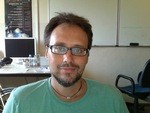Guest lectures and seminars - Page 120
In this talk, we will present some applications of the "transfer" to
algebraic K-theory, inspired by the work of Thomason. Let A --> B be a
G-Galois extension of rings, or more generally of E-infinity ring spectra
in the sense of Rognes. A basic question in algebraic K-theory asks how
close the map K(A) --> K(B)^hG is to being an equivalence, i.e., how close
K is to satisfying Galois descent. Motivated by the classical descent
theorem of Thomason, one also expects such a result after "periodic"
localization. We formulate and prove a general lemma that enables one to
translate rational descent statements as above into descent statements
after telescopic localization. As a result, we prove various descent
results in the telescopically localized K-theory, TC, etc. of ring
spectra, and verify several cases of a conjecture of Ausoni-Rognes. This
is joint work with Dustin Clausen, Niko Naumann, and Justin Noel.
The Bass-Quillen conjecture states that every vector bundle over A^n_R is
extended from Spec(R) for a regular noetherian ring R. In 1981, Lindel
proved that this conjecture has an affirmative solution when R is
essentially of finite type over a field. We will discuss an equivariant
version of this conjecture for the action of a reductive group. When R =
C, this is called the equivariant Serre problem and has been studied by
authors like Knop, Kraft-Schwarz, Masuda-Moser-Jauslin-Petrie. In this
talk, we will be interested in the case when R is a more general regular
ring. This is based on joint work with Amalendu Krishna
Enrico Fermi and the birth of modern nonlinear physics
In the early fifties in Los Alamos E. Fermi in collaboration with J. Pasta and S. Ulam investigated a one dimensional chain of equal masses connected by a weakly nonlinear spring. The key question was related to the understanding of the phenomenon of conduction in solids; in particular they wanted to estimate the time needed to reach a statistical equilibrium state characterized by the equipartition of energy among the Fourier modes. They approached the problem numerically using the MANIAC I computer; however, the system did not thermailize and they observed a recurrence to the initial state (this is known as the FPU-recurrence). This unexpected result has led to the development of the modern nonlinear physics (discovery of solitons and integrability). In this seminar, I will give an historical overview of the subject and present the different approaches that have been proposed in the last 60 years for explaining this paradox. Very recent results on the estimation of the time scale and on the explanation of the mechanism of equipartition will also be discussed.
In Part 2 we will delve into the worlds of derived and spectral algebraic
geometry. After reviewing some basic notions we will explain how motivic
homotopy theory can be extended to these settings. As far as time permits
we will then discuss applications to virtual fundamental classes, as well
as a new cohomology theory for commutative ring spectra, a brave new
analogue of Weibel's KH
In Part 2 we will delve into the worlds of derived and spectral algebraic
geometry. After reviewing some basic notions we will explain how motivic
homotopy theory can be extended to these settings. As far as time permits
we will then discuss applications to virtual fundamental classes, as well
as a new cohomology theory for commutative ring spectra, a brave new
analogue of Weibel's KH
